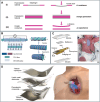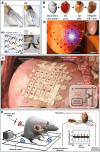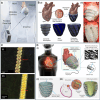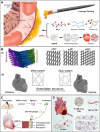Materials Advances in Devices for Heart Disease Interventions
- PMID: 40244561
- PMCID: PMC12243731
- DOI: 10.1002/adma.202420114
Materials Advances in Devices for Heart Disease Interventions
Abstract
Heart disease encompasses a range of conditions that affect the heart, including coronary artery disease, arrhythmias, congenital heart defects, heart valve disease, and conditions that affect the heart muscle. Intervention strategies can be categorized according to when they are administered and include: 1) Monitoring cardiac function using sensor technology to inform diagnosis and treatment, 2) Managing symptoms by restoring cardiac output, electrophysiology, and hemodynamics, and often serving as bridge-to-recovery or bridge-to-transplantation strategies, and 3) Repairing damaged tissue, including myocardium and heart valves, when management strategies are insufficient. Each intervention approach and technology require specific material properties to function optimally, relying on materials that support their action and interface with the body, with new technologies increasingly depending on advances in materials science and engineering. This review explores material properties and requirements driving innovation in advanced intervention strategies for heart disease and highlights key examples of recent progress in the field driven by advances in materials research.
Keywords: biomaterials; cardiovascular disease; devices; heart disease; tissue engineering.
© 2025 The Author(s). Advanced Materials published by Wiley‐VCH GmbH.
Conflict of interest statement
The authors declare no conflict of interest.
Figures














Similar articles
-
Cardiac Surgery.2024 Sep 3. In: StatPearls [Internet]. Treasure Island (FL): StatPearls Publishing; 2025 Jan–. 2024 Sep 3. In: StatPearls [Internet]. Treasure Island (FL): StatPearls Publishing; 2025 Jan–. PMID: 30422530 Free Books & Documents.
-
Sexual Harassment and Prevention Training.2024 Mar 29. In: StatPearls [Internet]. Treasure Island (FL): StatPearls Publishing; 2025 Jan–. 2024 Mar 29. In: StatPearls [Internet]. Treasure Island (FL): StatPearls Publishing; 2025 Jan–. PMID: 36508513 Free Books & Documents.
-
How lived experiences of illness trajectories, burdens of treatment, and social inequalities shape service user and caregiver participation in health and social care: a theory-informed qualitative evidence synthesis.Health Soc Care Deliv Res. 2025 Jun;13(24):1-120. doi: 10.3310/HGTQ8159. Health Soc Care Deliv Res. 2025. PMID: 40548558
-
Transition of care for adolescents from paediatric services to adult health services.Cochrane Database Syst Rev. 2016 Apr 29;4(4):CD009794. doi: 10.1002/14651858.CD009794.pub2. Cochrane Database Syst Rev. 2016. PMID: 27128768 Free PMC article.
-
Automated devices for identifying peripheral arterial disease in people with leg ulceration: an evidence synthesis and cost-effectiveness analysis.Health Technol Assess. 2024 Aug;28(37):1-158. doi: 10.3310/TWCG3912. Health Technol Assess. 2024. PMID: 39186036 Free PMC article.
Cited by
-
Mechanobiology in Action: Biomaterials, Devices, and the Cellular Machinery of Force Sensing.Biomolecules. 2025 Jun 10;15(6):848. doi: 10.3390/biom15060848. Biomolecules. 2025. PMID: 40563488 Free PMC article. Review.
References
-
- Martin S. S., Aday A. W., Almarzooq Z. I., Anderson C. A. M., Arora P., Avery C. L., Baker‐Smith C. M., Barone Gibbs B., Beaton A. Z., Boehme A. K., Commodore‐Mensah Y., Currie M. E., Elkind M. S. V., Evenson K. R., Generoso G., Heard D. G., Hiremath S., Johansen M. C., Kalani R., Kazi D. S., Ko D., Liu J., Magnani J. W., Michos E. D., Mussolino M. E., Navaneethan S. D., Parikh N. I., Perman S. M., Poudel R., Rezk‐Hanna M., et al., Circulation 2024, 149, 347.
-
- Townsend N., Kazakiewicz D., Lucy Wright F., Timmis A., Huculeci R., Torbica A., Gale C. P., Achenbach S., Weidinger F., Vardas P., Nat. Rev. Cardiol. 2022, 19, 133. - PubMed
-
- Mirzajani H., Kraft M., ACS Sens. 2024, 9, 4328. - PubMed
-
- Rothman S. A., Laughlin J. C., Seltzer J., Walia J. S., Baman R. I., Siouffi S. Y., Sangrigoli R. M., Kowey P. R., J. Cardiovasc. Electrophysiol. 2007, 18, 241. - PubMed
Publication types
MeSH terms
Substances
Grants and funding
LinkOut - more resources
Full Text Sources
Medical

